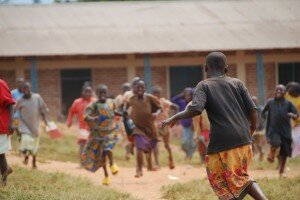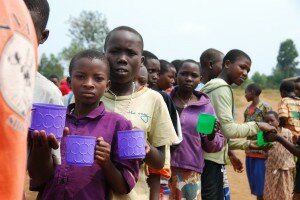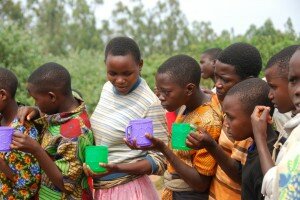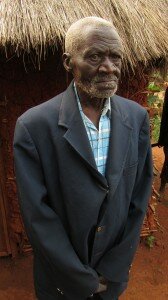Part three of our four part series featuring award-winning producer Jessica Stuart’s stories from the field:
Wednesday, June 22nd, 2011 – Karuzi
We travel 4 hours of bumpy, dusty roads- passing through tea plantations, getting into traffic jams with cattle, to reach the Karuzi Province. This is a place that doesn’t often have outside visitors, so the cars themselves were a spectacle of mass proportion; not to mention the blonde sunburned woman and the tall South African man with sound gear strapped to him.
We visited a school called Canzikiro and were greeted by thousands of smiling faces. And yet, I am great crowd control because children think I am a ghost or an angel, they either run away or run to me!
We spoke with a teacher and she enthusiastically told us that she sees more children coming to school because they are healthy and because their families are healthy. She has seen a difference of children paying attention in class and able to focus. The teacher, herself was pregnant. She miscarried the first time, possibly due to anemia from worms herself, but is looking forward to the birth of her first baby next month. There is possibility.
In the afternoon we traveled down more bumpy roads to Bugenyuzi,, a community with approximately 11 percent of the population suffering from Trachoma. This is a new program and the inhabitants of this community press us for more. They want to know when we are coming back, when the next round of medicine is coming, and how we can help stop the suffering. The area we are in is difficult to get to. The word “remote” doesn’t do justice to its location. These are the bottom billion. These are the poor that are rarely reached, stuck in a cycle of poverty, yet with a desire to do for themselves. They just need a lift, a boost; and we can do that for less than 50 cents. The drugs are there. The knowledge is there. We can eliminate NTDs even from the places and in the corners no one is looking.
That evening, we sit down to a goat brochette, a gin and tonic and a cold shower from a bucket and a cup. There are no mosquito nets, so I sleep with my hooded sweatshirt on, a half bottle of DEET burning my skin, and hope for the best.Malaria is the least of my worries at this point.
THURSDAY, June 23rd, 2011 –GITEGA PROVINCE

Baby waiting for MDA in Gitega
Down more dusty and bumpy and neck -spraining roads, we head to Gitega, the former Capitol of Burundi. Willy, our amazing driver, seems to put me right to sleep when he’s driving–I’m out cold along the way.
We arrive in the village of Rutoke I. It’s very exciting for our translator Gerard, because this is his hometown. He shines with pride as we head to the clinic. The clinic is filled with women. It’s colorful. It’s clean. It’s joyful in some ways. A nurse runs off, telling me she’s about to go deliver a baby. We ask if we could film it and the mother said yes. By the time we got to the room she had already delivered. We later found out that she got up, and walked home with her newborn within 15 minutes of having the baby.
At the clinic, we met Georgette, a 42-year-old mother of five. Georgette is also a community health worker. If she was anywhere else in the world, I’m certain she’d be a CEO, a doctor, or the President of the country. She is smart, kind, self-sufficient, and for some reason, we are able just to naturally communicate although we don’t speak the same language.

Crew interviews Georgette in Rutok

Georgeette!
Georgette took us to her home. We drove as far as we could and then hiked about 30 minutes into the center of pristine and lush forest. Gerard, our translator, and said “Welcome to the heart of Africa!” We were truly in the middle of Africa. It was quiet, beautiful, and green.

Georgette and her family pick beans at home
Georgette told us stories about her children so sick with worms, she could not work. Worms would crawl out of their feces, out of their noses. They would vomit hundreds of worms at a time. Their bellies would extend. They couldn’t eat. They were too sick to go to school, too tired to function.

Georgette and her children
Today, we see a different home. We see a prospering mother. We see children picking beans, home for their lunch break. Shy to the cameras, Georgette eeks out a few smiles as she sings to them, nurtures them, mothers them. She reminds us that they are the future of Burundi, and only with their health can they prosper. The team all takes a minute to remember why we do our jobs; why we travel so far to tell one story? Georgette says it all for us.
Jessica Stuart is an award winning producer and consultant. Her video work and live productions have been seen around the globe- on television, the web, and in theaters. She has worked for NBC Network News, The Today Show, The Oprah Winfrey Show, ABC Network News, and The Bill and Melinda Gates Foundation. In September 2008, Jessica created Long Story Short Media, an independent creative consulting and producing firm, specializing in short form, multi-use content. She lives in Washington, DC with her husband, David, her son Alexander, and their rescue dog, Riley Martin.




